Wildebeest
Hello Africa, here is one of the most successful herbivores, also known as gnus, wildebeests are members of the antelope family.
-
Habitat: open Savannah and woodland
-
scientific name: Connochaetes sp
-
Adult weight: 250-300kg
-
IUCN status: less concerned
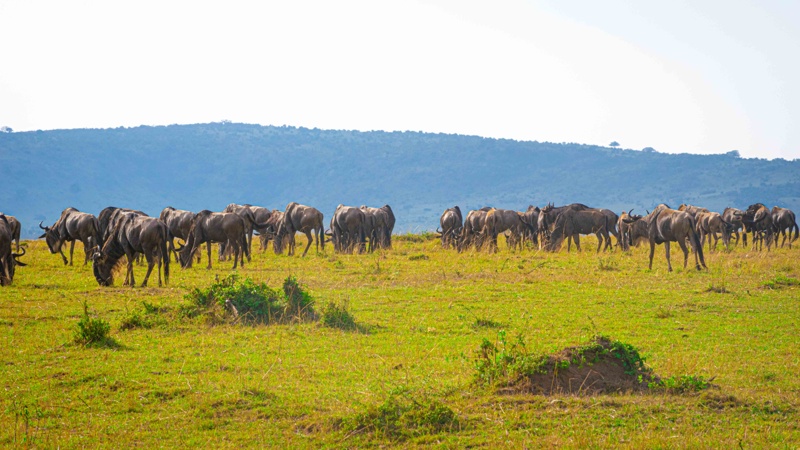
Quick facts about wildebeest-gnus
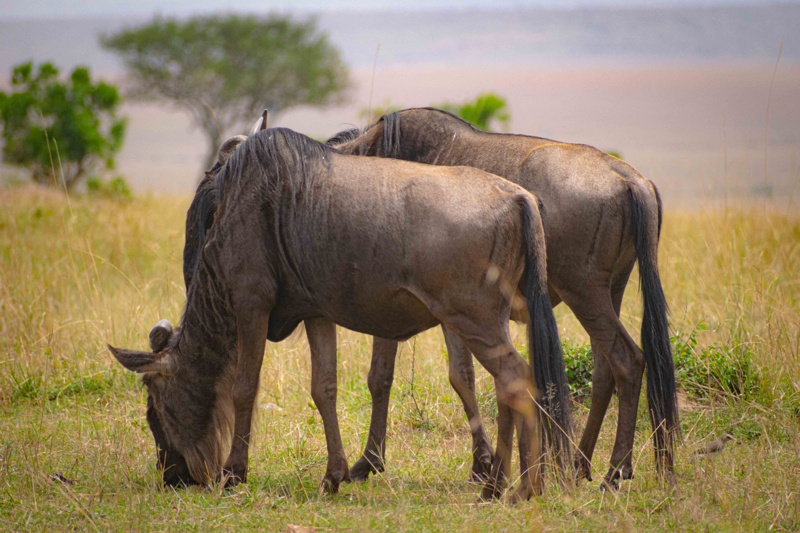
Wildebeests are known to be great migrators and always gather in large herds while preparing for long journeys.
Females often give birth during the rainy season with a gestation period of 8-8.5 months and the most witnessed one is the Ndutu conservation area that gathers thousands of these animals in the months of late January to march when they are so active in production. This is a place where all photographers wish to be, it collects all kinds of cats like leopards, lions, cheetahs, hyenas, and many others.
These awkward-looking creatures have a heavily built front end, a large box-like with curving horns, and slender hindquarters with spindly legs. They have an attractive gray coat and black mane as well as a white or black beard and luxuriant tail.
Wildebeests are social animals and always mixing up with zebras, topis, kobs, and many others, these are known to be so fast able to drift at 64km/hr, they are good at dodging predators however they are always among the targeted dish for these no mercy animals.
By the age of 4-5, single herd males become quite territorial and leave the herd to form their own, Females establish tiny, overlapping herds, and as groups approach, cows shift to a different herd. These stay with calves till the next baby is born.
When bulls meet at the edge of their territory, they frequently challenge each other by bucking, snorting, scratching the ground, fighting, and growling in low tones. They crouch with their foreheads on the ground, prepare to battle, and step forward to hit each other, banging their heads and horns but rarely injuring each other. There is a suggestion that these duels enhance hormone levels in bulls because bachelor groups are more laid back.
Their habitat is threatened by agricultural activity and fragmentation, and even though a considerable number of wildebeests have died during the Great Migration, the International Union for Conservation of Nature does not rank wildebeests as endangered.
Where to see wildebeests
Kenya and Tanzania are well known because of their wonder migration; however, they are also most spread in the south of Africa.
OUR SAFARIS
[pt_view id=”5884fd9war”]
White Rhinos
The white rhino,broad-lipped rhinoceros is the largest and most numerous of the world’s five rhinoceros species. It’s most social and approachable than all rhino species.
-
Scientific name: Ceratotherium
-
Habitat: Woodland Savannah
-
Adult weight: 1,800–2,700kg
-
Life expectancy: 50 years+/-
-
IUCN status: Near Threatened
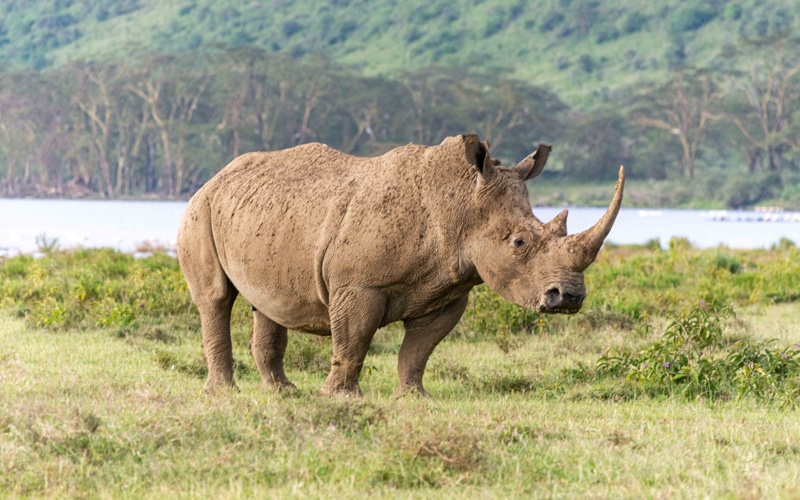
Quick Facts
The white rhino is the world’s second-largest land animal after the elephants and, on average, nearly twice the weight of the black rhinos. During the hot sun, white rhinos usually take cover by lying in the shade.
white Rhinos also wallow in mud, they always find a suitable water hole where they roll in its mud, and this helps coat their skin with a pure natural bug repellent and acts as a sunblock. Females always produce every after 3 years and the calf is born hornless.
Rhinos are excellent at hearing and have an outstanding sense of smell. They always find one another by following the trails of scents each enormous animal leaves behind it on the landscape.
solitary life in adult bulls is hereditary, they have to mark their presence and territories using very large dung middens.
Where to see white rhinos in Africa
White Rhinos can easily be seen in lake Nakuru national park, OlPajeta conservancy, Ziwa rhino sanctuary in Uganda, and some sightings in Akagera national park-Rwanda

Top tips for viewing white rhinos
These are animals that prefer a calm environment to noise while tracking their silence is the key goal. Following the midden, footprints sometimes help to spot these rhinos, they prefer shade when it’s hot and drink water more often so water holes can also be a good spot. During the rainy seasons, white rhinos shift to areas with more soft and greener pastures, so this helps to spot them as well.
Holiday ideas to see white rhinos
We tailor the best holiday packages that will enable spot these white rhinos
OUR SAFARIS
[pt_view id=”5884fd9war”]
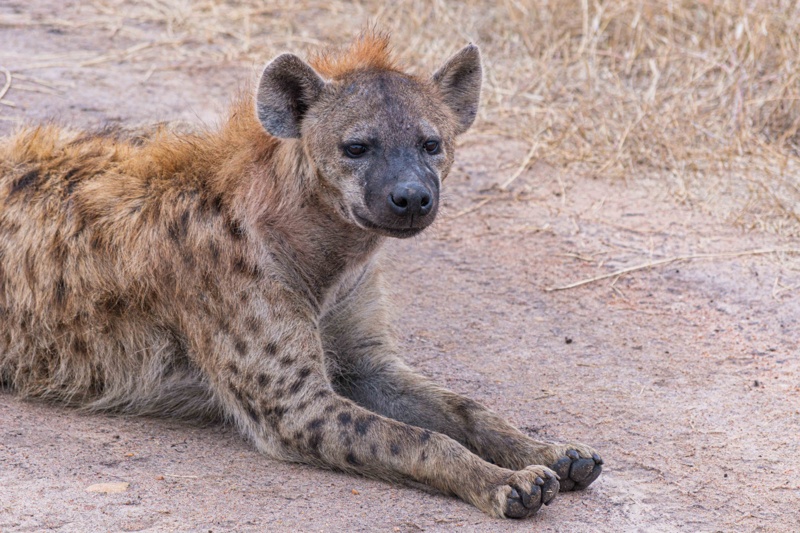
Spotted Hyena
The spotted hyena is the most common member of a family of large, round backed-hunchbacked carnivores whose somewhat canid appearance belies with a closer relationship to cats and mongooses. Often portrayed as an exclusive scavenger, the spotted hyena is a proficient hunter with the ability to kill an animal as large as an eland
-
Biting power than a leopard: 40%
-
Adult weight: 40-85kg
-
Scientific name: crocuta
-
Meat per sitting: 13-15kgs
Quick facts about Spotted Hyenas
Hyena clans are led by females, strong and bigger than males, the spotted hyena’s laugh Is actually a sound made to alert other members about any food opportunities and this call can easily be heard 3 miles away.
Spotted hyenas are purely skilled hunters and good at scavenging, their powerful jaws tear everything on their prey. The only parts that survive the justice are the horns, hair, and hooves which are regurgitated in pellets.
Spotted hyenas can reach terrifying speeds.
Managing speeds of up to 60kmhr means a group of 3 to 5 hyenas can put down a slower running prey. Combining this with their extra ordinary teamwork has had hyenas recorded putting down midsize wildebeests while an attempt on a cape buffalo can’t be ruled out.
The spotted hyena acidic stomach
Their strong acidic stomach is only beaten by vultures their scavenging buddies so hyenas are capable of digesting disease infested carcasses with no damage.
The spotted hyena immunity levels.
The spotted hyenas have a strong immunity to protect them against everything they encounter in the wild but this does not come cheap. The higher the rank, the stronger the immunity as these leaders engage in less activity , are less hurt, nurse less wounds however take the first and biggest share of a kill.
The lower the rank, the weaker the immunity, and most males are victims of this, for they fight the more, get more injuries yet eat the last bony pieces of a kill if any and they have been reported to die half early as their female bosses.
The spotted hyena fusion-fission society
A fission-fusion society means spotted hyenas prefer to cooperate on hunting missions but give each other space when this is done to avoid unnecessary confrontations which can lead to severe fights, injuries, and deaths.
Hyenas are fascinating to watch while in their clans of 10-30 individuals.
Nepotism in spotted hyenas
Nepotism has also been spotted among hyenas as offspring of a dominant female outrank adult subordinate female hyenas. However, tables can turn especially when the mother is not around and every hyena stamps its authority over the other.
Male spotted hyenas take little or no part in cub rising but when they do, it’s their daughters that they prefer and the latter in return act less aggressively towards their fathers.
Territory marking in spotted hyenas
Setting boundaries is something spotted hyenas take seriously and if they have been spotted terminating the chase immediately after prey crosses into another territory.
Persistence however is the key to success if any immigrant male is to stand a chance to stay in a foreign clan or even win a mate there.
Mating in spotted hyenas.
Mating in hyenas is quite a complicated and laborious task for the male as maximum cooperation is essential and females have all rights to choose who to mate with and forced copulation is almost impossible.
Rare fact A hyena’s heart is relatively big as it takes 1% of its body weight, in contrast to a lions 0.57% its body weight. The bigger heart size is meant to sustain the spotted hyena’s efforts why chasing down prey for some distance
Why are female spotted hyenas masculine, dominant and aggressive?
With a gestation period of about 4 months, dominant females are known to provide more androgen hormones to their offspring in the older stages of pregnancy, unlike the lower-ranking females.
It is this androgen that makes the babies of dominant females more aggressive and musculinised than their colleagues. For this reason, they rank higher than some older females and stand a chance of taking over as leaders if they can win several allies.
Giving birth in hyenas
Giving birth in female spotted hyenas is as hard as conceiving since newborns have to use the narrow clitoris tube to find their way out in the entire carnivore family, spotted hyena cubs are a match like no other in size ratio to their mother’s weight.
With all the force used throughout the birth process, the clitoris raptures and is known to take a few weeks before it heals.
Everything looks against their odds of survival but regardless they move. And nature seems to keep pushing for reduced hyena levels.
Why do female and male genitalia look alike in spotted hyenas?
Brains are still at work and researchers are still looking for reasons for the transformation of female spotted hyenas to resemble the males.
How do spotted hyenas sleep?
Hyenas are also known to den like lions while some choose single dens for long periods; others prefer to shift after short periods.
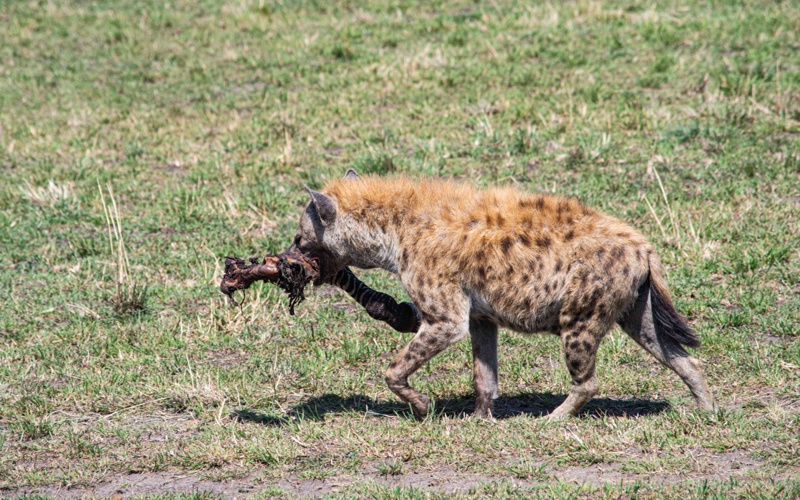
Where to see spotted hyenas
Spotted hyenas are fairly seen both during day and night however more active in night hours and are always near lion pride. They are well observed in Savannah, woodland, and desert areas, with a distinctive call that just tells where they are.
Top Tips for seeing spotted hyenas
Spotted hyenas are adept animals and with a loud noise, they are seen closely during the night but can as well be seen at any time of the day. During hot hours they hide under thickets and big trees or in their dens. They are as well visible with cubs laying closer to the tracks and following lions, leopards, and other predators. They are known to be the invited guests at any party, following their moving patterns also helps
Are hyenas the best part of the ecosystem?
HOW ARE HYENAS IMPORTANT IN WILDLIFE?
Rarely known is the fact that hyenas are hygiene enforcers in nature. Poor hygiene in your dining, kitchen, or even living room can bring about serious diseases that can lead to death.
The same is true in the wilderness; an anthrax infected carcass if not removed can spread and kill thousands of wildlife species ranging from insects to even the big animals.
With this continuously happening, our national parks would be inaccessible due to the stanching smell of dead carcasses all over. Nevertheless, wildlife numbers would significantly drop.
We are blessed to have these serious mess cleaners as they will ingest and digest any part of a dead animal, be it sick or not thanks to their stomach acidic PH.
At less than 2 and only beaten by vultures in strength, the spotted hyena acidic PH allows it to breakdown every animal part while its short digestive tract provides less room for micro organs to roam in its body.
Spotted hyenas alongside vultures are natures hygiene specialists in a world of predation.
Raising awareness about hyenas
Providing relevant information and raising awareness means the spotted hyena misconceptions are cleared, leaving them to roam freely on their savannah territories and give nature a chance to dictate.
At numinous African Safaris we spearhead and enforce conservation and sustainability for all wildlife, maintaining a harmonious relationship between wildlife, people, stakeholders and mutual benefit for all parties involved
Holiday ideas to see the spotted hyenas
It’s a great idea to move around the African game parks, these creatures shall always bring the best experience
OUR SAFARIS
[pt_view id=”5884fd9war”]
About Roan
Renowned for its bravery in fighting off predators, the roan is Africa’s second largest antelope, Shaggy looking well built with distinctive colors is a special encounter.
-
Scientific name: Hippotragus equinus
-
IUCN status:Least Concern
-
Habitat: Savannah woodland
-
Adult weight: 180–300kg
Quick Facts
Roan antelope has a light red-brown coat, a small mane on the back of the neck, and short backward-curving horns. Male roans are known to be polygamous managing over 15 females, however it excludes its self from the rest within a radius of 500 miles. Good at defending its herd and vigorously fighting against the predators like leopards, lions, and many others. Roan antelopes prefer to graze on grass but also feed on herbs, shrubs, and Acacia tree pods. They must drink regularly and also inhabit where water is easily accessed.
Newly born calves are kept in the thickets for about a full month, till they gain much momentum to survive in the wild. This is as well so risky for these young ones because mothers have to go and feed them, leaving them prone to ruthless predators.
Where to see roan in Africa
Allow it plenty of space or it will definitely disappear, this handsome roan, is very shy and can easily be seen around water holes or when, in large herds. it’s widespread in most Savannah areas however it’s becoming locally extinct in most areas of central, South Africa and West Africa.
Top tips for viewing roan
-
prepare to view these incredible animals at a distance or you will scare them, they are shy animals and prefer less noise and more privacy. Nowhere are they numerous, this remains one of the rarer antelopes seen on an African safari. incredibly small groups are usually seen when venturing warily out of cover to drink at waterholes.
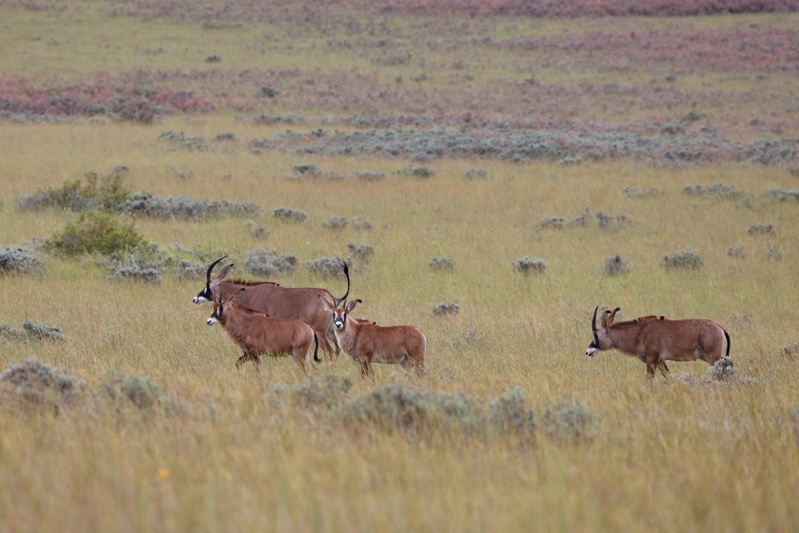
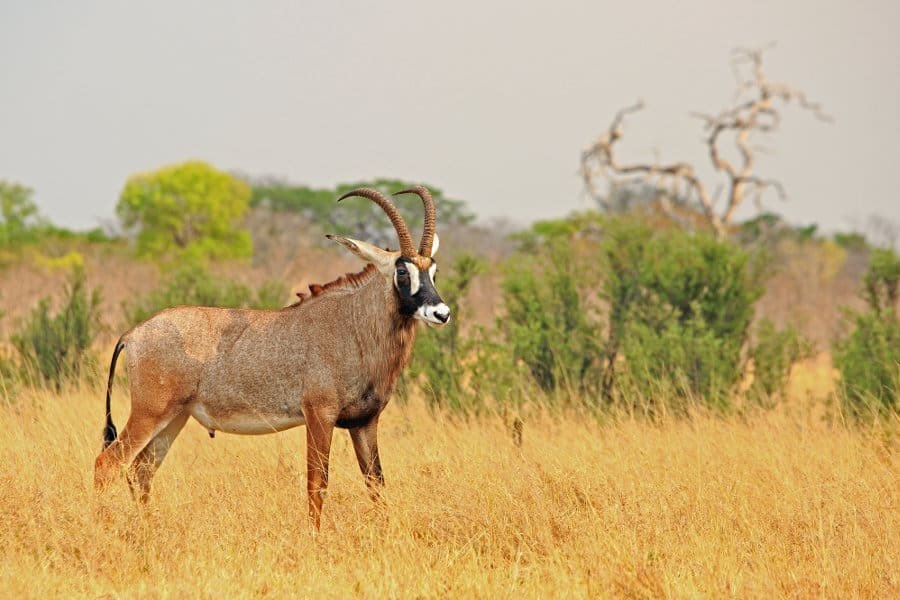
Holiday ideas to see roan antelope
Having a sighting of the roan antelope is truly outstanding, let’s take you there.
OUR SAFARIS AND BLOG NEWS
[pt_view id=”5884fd9war”]
Mountain gorillas
Mountain gorillas are the bulkiest members of the primate family ,found in the albertine rift. Only shared by two localities namely the virunga mountains( shared between DRC,Uganda’s and Rwanda) and Uganda’s Bwindi impenetrable national park.
-
Scientific name: Gorilla beringei beringei
-
IUCN status: Endangered
-
Habitat: montane cloud forests
-
Adult weight: 150-210kg
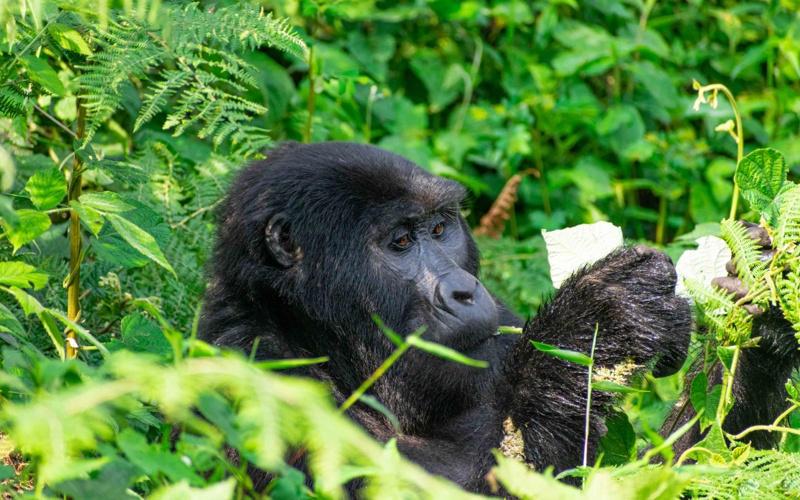
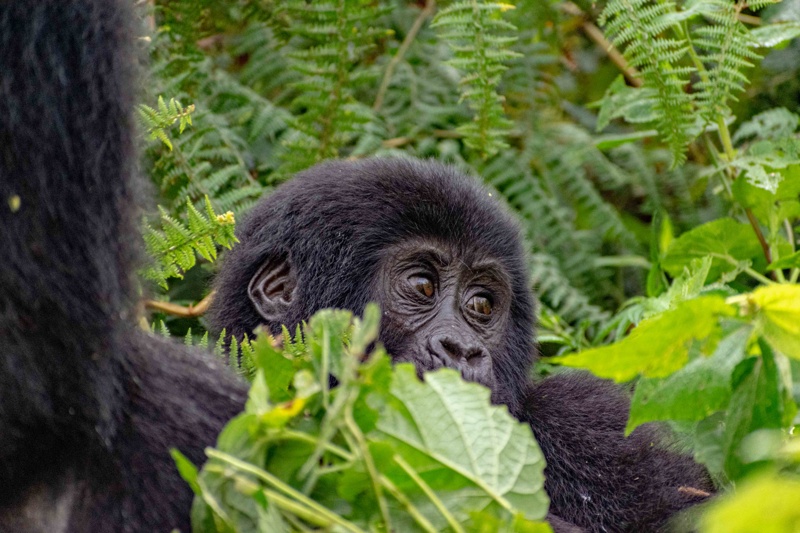
Tips for viewing mountain gorillas
-
Tracking the mountain gorillas in the Virunga mountains or Bwindi impenetrable national ranks among the absolute highlights of African travel. These great apes are thorough monitored by park rangers to ease the tracking and knowing how they are doing. This experience should not be a challenge to anyone , however one is required to be fit regardless of which age, considering the altitude levels.
-
For photography, flashlight is forbidden and we as well advice you to run off a few quick snapshots then keep your camera and enjoy the moment.
Quick facts about mountain gorillas
Gorillas are the worlds largest primates and have been recorded among the most endangered species. Its indeed promising that the global population is shooting higher beyond 1000 of which Uganda holds the highest numbers.
We share 98% of their DNA and they display uncanny human characteristics. The silverback heads the family and selects the feeding and sleeping places for the whole group. READ MORE
The gorilla is considered to be highly intelligent and gentle, and with a variety of communication vocal sounds.
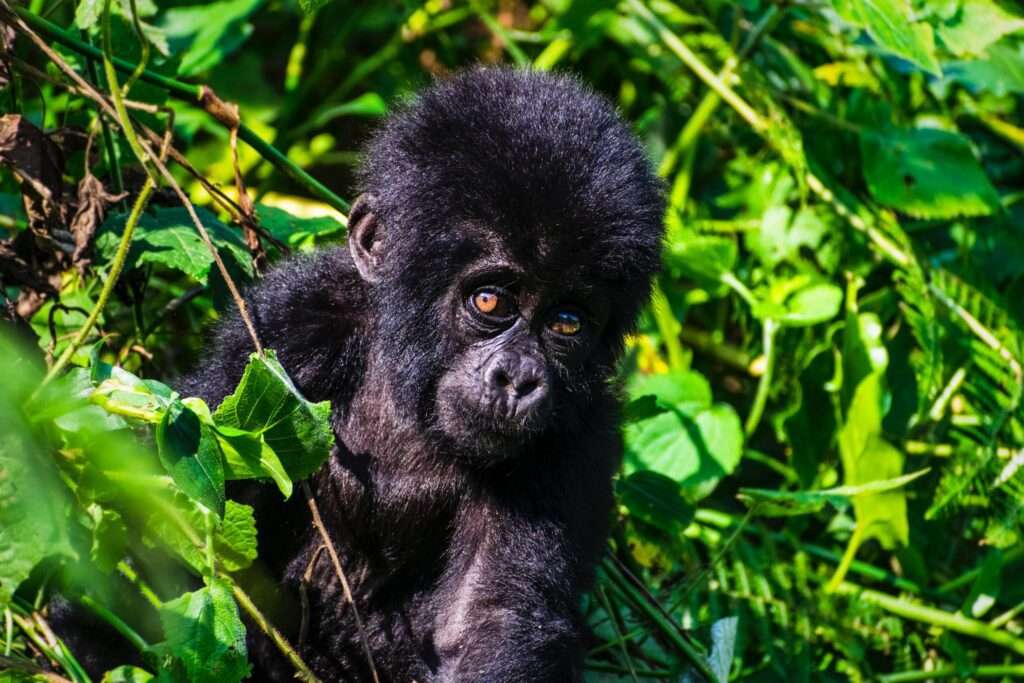
Holiday ideas to see mountain Gorillas
Basing on our ground experience these constructed ideas shall bring you closer to these primates and elevate your experience while in Africa.
OUR SAFARIS
[pt_view id=”5884fd9war”]
Leopards
African leopards are most common of the large felines, living often closer to humans but are seen because of their secretive, solitary nature. Having a chance to view this creature is considered the best luck of the safari.
-
Scientific name: Panthera Pardus
-
Adult weight: 30-100kg
-
IUCN status: Vulnerable
-
Habitat: Savannah, forests, and mountains
Quick facts about the leopard
African Leopards are known to be excellent stalkers getting 5m closer to the intended prey before pouncing. They can keep their kill in trees to keep it from being poached by other predators like hyenas and lions.
Leopards hunt using power and stealth and can easily be distinguished from cheetahs by their rosette-shaped spots, more powerful build, and preferred habitats such as rocks or woodlands. Leopards are not easy to spot because of high camouflage, but when given a keen observation by our experts then your day can be enlightened.
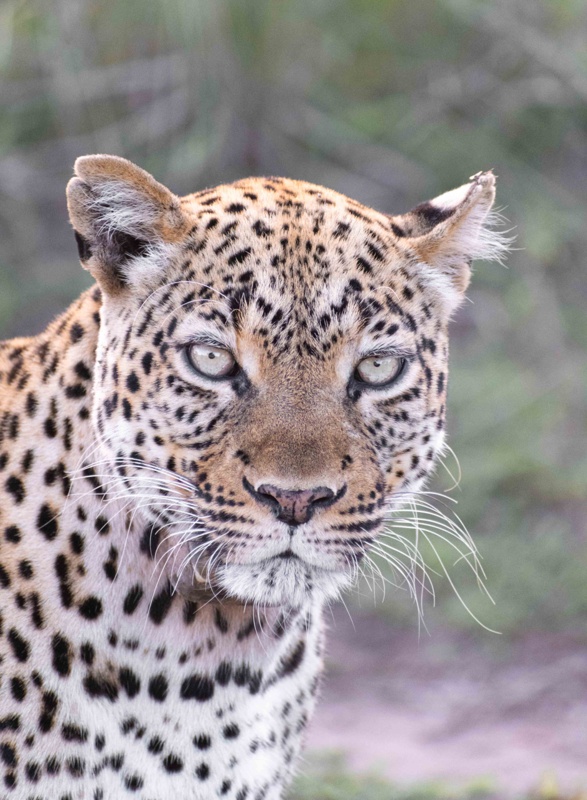
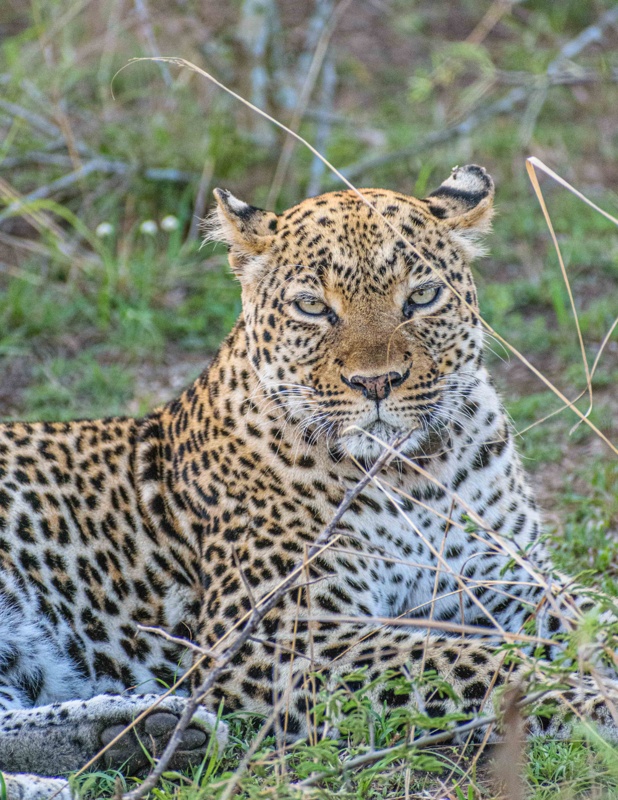
Where to see leopards in Africa
Leopards are widespread everywhere in most countries but are very hard to spot. Murchison falls national park In Uganda has more chances-80% and also parks like queen Elizabeth national park, Kidepo valley national park, Masai mara has 75%, Serengeti has 75%, Samburu has 45%, South African parks 75%.
Top tips for viewing leopards
-
Like any other feline, the leopard is typically nocturnal but usually visits similar areas for some time. It can be seen during the day in the trees or anywhere by chance. Night drives create high chances and waking up early is also a key factor. Leopards are gentle animals and prefer living a solitary life at a certain age, they can be seen as a family while mating or when still young and groomed by the mother and this brings more hope in seeing these creatures.
Holiday ideas to see leopards
Its an adventure like no other, basing on our experience we bring you to see these mighty creatures
OUR SAFARIS
[pt_view id=”5884fd9war”]
Giraffes
Giraffes are the world’s tallest land mammals towering above the African bushes with their distinctive colors, these gentle walkers are a major highlight for most of our safari goers.
-
Scientific name: Giraffa Camelopardalis
-
Habitat: woodland Savannah
-
IUCN status: vulnerable
-
Adult weight: 800-1200kg
Quick facts about Giraffes
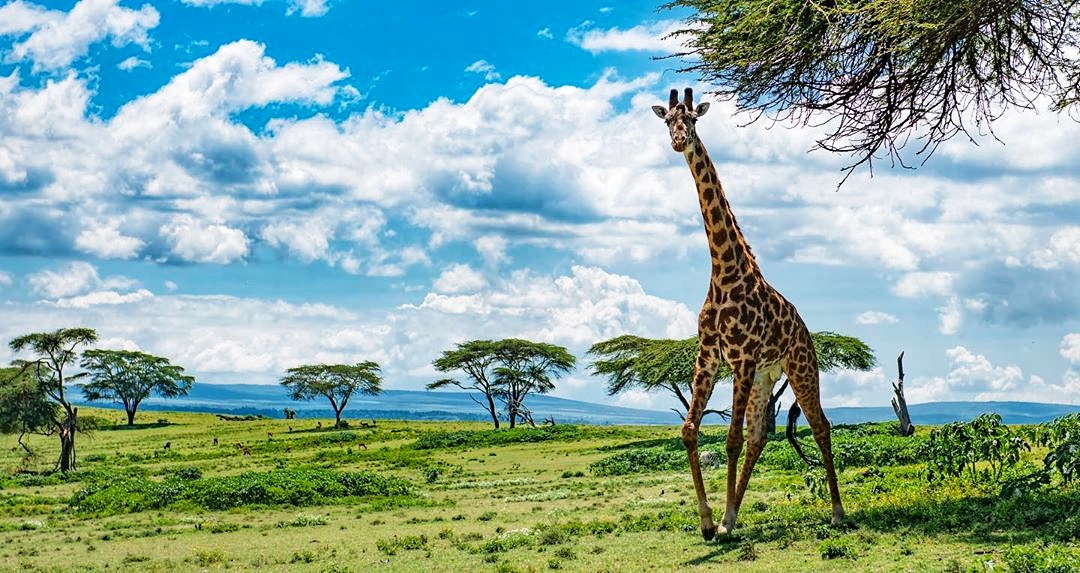
Confusing the early explorers who thought its a cross between a leopard and a camel, the giraffe is indeed an awkward-looking living creature.
The giraffes have a unique movement of both right legs simultaneously, followed by both left legs.
Giraffes delicacy is the spiky acacia that it strips using its dark purple tongue.
Despite their height and their calves being born 2m tall, the giraffe’s neck contains only 7 vertebrae-exactly the same as a human’s. Giraffes are known to be blessed by a strong behind kick which can easily kill a lion, its height and strength calls for almost whole to put down a mature giraffe
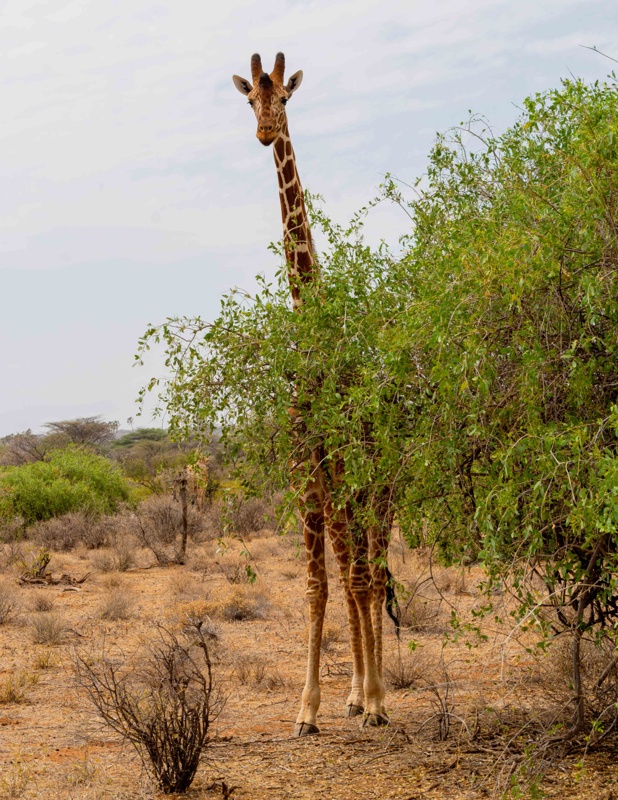

Where to see giraffes in Africa
Africa is blessed with a number of giraffe species, taxonomists recognize 9 however there are speculations of more subspecies.
Roth’s child giraffes, Masai giraffes, and reticulated giraffes are among the most common species you could see while in the game parks
Tips to see giraffes in Africa
These vigilant animals that always get at the top of most areas, are easily visible and always counted as unlucky missing them.
-
Giraffes are so gentle and less intimated even getting so close on foot, it’s always much easier while wanting to take photos and film these massive creatures. Giraffes prefer less noise and fewer movements so while at a closer range silence and controlled movements are put in order. Water holes are a good gathering point for these giraffes, watching them in the drown out a caution, necking, and males swinging necks fighting for dominance is worth an adventure.
Holiday ideas for seeing the African giraffes
Witness what nature can deliver as we take you on an epic African safari
OUR SAFARIS
[pt_view id=”5884fd9war”]
Gerenuks in Africa
Gerenuks in Africa are notably tall, slender antelopes that resemble gazelles, and appear by its long, slender neck and limbs. The gerenuk is a specialist in browsing and often stands on its behind legs to reach further for the soft leaves.
Quick facts about gerenuk
Scientific name: Litocranius walleri
Habitat: Flat, dry thorn bush
Adult weight: 28–52kg
IUCN status: Near Threatened.
Gerenuk is diurnal, highly social creatures forming small single-sex herds of 2-6 individuals. Females sometimes contain juveniles in their herds as males prefer living a solitary life. They are so peaceful animals and rarely fight, gerenuks are sedentary meaning there are no travel intentions and this helps them to preserve foraging energy.
The gerenuk males defend their territories by scent marking with their special secretions from the preorbital glands. As they age, the gerenuk is less mobile, and eating from closer rangers is always the best choice. With about 25-44 cm of horn length,3-6km2 of home range, and 2m of feeding height these are ideal to spot.
These are animals that can be identified at a distance due to their height and rotations, scanning around thickets and not getting too closer are the best way to spot these giraffe antelopes.
Gerenuks are so wise and use several vocalizations, such as a whistle when annoyed, a buzzing sound when alarmed, an extremely loud bleat when in danger, and a soft bleat when females communicate with their young ones
Top tips for viewing gerenuk.
Highly adaptable and loves bushes and thickets avoids dense bushes and avoids too open areas.
It’s widespread in the horn of Africa and pushes to Kenya and some parts of Tanzania.


Holiday ideas to see the gerenuk
The desert specials can be seen in the drier countries of the northeast of Kenya-Samburu national reserve, parts of Tanzania, and other Laikipia golden locations. It’s our sincere, mandate to bring out the best in these desert dwellers.
OUR SAFARIS
[pt_view id=”5884fd9war”]
The African Giants
World’s largest land mammal, a sight to behold on Africa’s sprawling Savannah. Regarded to be among the most intelligent animals and always entertaining for all the safari-goers.
Weighing over 6 tons(6000kg) and measuring up to 11 feet shoulder height, the African elephant is second to none on land and is the world’s largest land mammal. In order to sustain its enormous size, the African elephant can consume up to 300 kg of vegetation in a single day which can stretch up to 18 hours of foraging, over almost 20km of distance.
Quick facts
-
Weight of brain: 5kgs+
-
Adult weight: 2500kg-6500kg
-
IUCN status: vulnerable
-
Scientific name: Loxodonta africana
-
Elephants have large brains | The brain of an elephant is approximately 4 to 5 kg which is 4 times the size of a human brain. The elephant brain has a bigger and denser temporal lobe which supports their incredible memory. It is from here that a saying was developed that Elephants don’t forget as they can recognize old faces, old tracks, and old landscapes.
-
Major threats to elephants in Africa: what are the major threats to Elephants? | Poaching and ivory trade remain the biggest threat. • Human-elephant conflict. • Habitat loss.
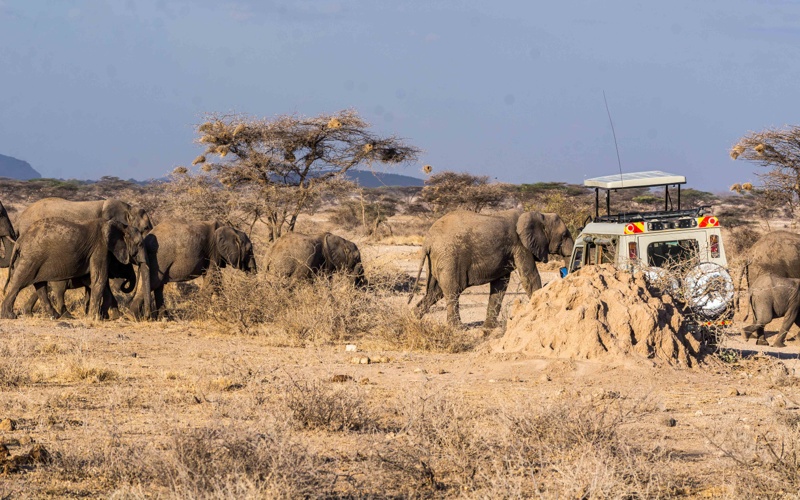
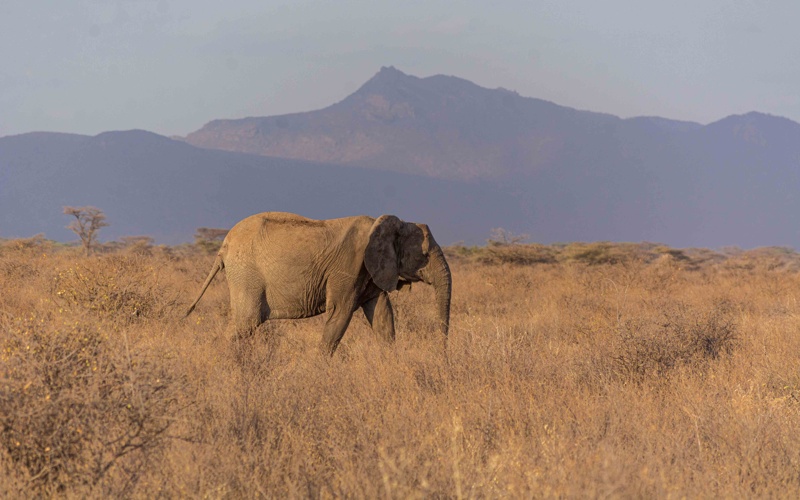
Female elephants live in closely knit clans in which the eldest female matriarch takes over the leading role over her sisters, daughters, and granddaughters.
Elephants are a positive to the ecosystem due to their large sums of feeds, they move around breaking down trees and eating bushes and shrubs which control most areas from turning into intact forests.
These giants siphon 30-50 gallons per day using their trunk, the truck is by far the most useful feature for digging, signaling, gathering food, and as well spray water all over their bodies.
Bush elephants are sociable, affectionate, and good at caressing companions, they will take care of the weaker individuals and are good at adopting the orphans
The elephant feet.
Their feet are spongy pads each with four or five toes, toenails and this helps elephants absorb the pressure from the ground due to their heavy weights.
MYTHS ABOUT ELEPHANTS
- Elephants are afraid of mice; no instead they are terrified by bees
- Elephants go to graveyards to die. Because elephant bones are found in groups a myth developed that they go to specific places to die there but this is probably because they were killed and collected in specific places. However, they mourn just like humans.
-
Elephants drink through their trunks. it’s strange to imagine something drinking through its nose, surprisingly in 3 seconds, the trunk is half filled with around 8 liters for squirting into its mouth.
- Elephants love peanuts, a theory developed in the 19th century when people paid to feed elephants sacs of peanuts in circuses and zoos.
-
The gestation period of elephants
Elephants have a 22-month gestation period and on giving birth, a baby elephant can stand in a minute while it can later swim in a few hours. This can be attributed to the vulnerability to predators of these babies and so they have little time to waste learning these life-saving tactics.
Breeding in elephants
-
A female usually bears a calf between 10 to 20 years and does so again after 4 to 6 years. They can give birth even in their 50s
Elephant diet
Elephants are primarily herbivores
Elephant diet contains grasses, bushes, twigs, fruits, tree barks, small plants, and sometimes roots, especially the fresh juicy ones.
Elephant species
There are 3 species of elephants, African savanah, African forest and Asian elephants. The latter occupies the forests of Asia while the former two are native to the savannah grasslands, woodlands and forests.
Differences between the African savannah and the African forest elephant
|
African savanah elephant
|
African forest elephant
|
|
· Larger in size
|
· Smaller and slender
|
|
· Short thick curved tusks
|
· Long thin tusks pointing downwards
|
|
· Africa shaped ears
|
· Round shaped ears.
|
|
· Brown-grayish in color
|
· Darker in color
|
Uses of elephant trunks
The elephant trunks are multipurpose tools with over 40000 to 150000 muscles; they can perform an unimaginable number of responsibilities for the elephant, and other wildlife in a mutual relationship.
They use their trunks for several purposes
- Rubbing and a touch for a greeting or assurance
- Spraying cool water over their hot bodies
- Used to play games with each other
- To bring down a tree branch with fresh juicy leaves
- To move bushes out of its way
- Digging holes in river beds to allow water to flow from the ground.
How do elephants communicate?
Elephants communicate through vibrations (small earthquakes) and are known to have a unique and complex communication system.
Elephants trample onto the ground to generate impulses that travel several miles and these vibrations are taken up and interpreted by the recipient through their bones.
Elephants also communicate through touch, taste, and smell while they are observed excitedly greeting each other even after many years of no contact
Roles of elephants in the ecosystem
Elephants are the landscape designers.
With their herbivorous feeding, elephants have been described as landscape architects as they shape trees by bringing down the oversized branches, and clear tracks in the dense forests.
Elephants are heavy feeders
Elephants can forage vegetation up to 300 kg in a single day, however, a big portion of this is passed out undigested this is the reason several species will be waiting for an elephant to excrete through the back door.
Elephants are expert dispersers.
From the undigested fruits to plant stems, elephants ensure plants and tree species migrate to other territories
Elephants provide food to other species.
Birds and baboons pick fruits and seeds from elephant dung, while plants also get their seeds dispersed to different areas and hence increase their chances of survival.
Any undigested plant stem can have another chance at life considering the fertile and nutritious environment the elephant dung provides
Elephants are manure manufacturers
With much of their intake excreted undigested, elephants supply a great amount of manure, especially to the savannah undergrowth like grass, small plants, shrubs, and even trees.
Where to see elephants in Africa
Where are African elephants found?
Elephants can be found in the tropical and subtropical regions of Africa and Asia while African elephants are in the savannahs, grasslands, highlands, swamps, and even deserts of Africa.
Uganda, Tanzania, Botswana, Namibia, Kenya, Zambia, and South Africa are some of the 23 countries that harbor these mammal giants.
Tips for viewing Bush elephants
-
These are big animals that don’t require over-straining your eyes, however, while viewing one must be keen on behaviors. Agitation of individuals and herds with calves must be given enough space. Bulls must as well be given enough space because sometimes are agitated by Musth.
-
You’re always advised to use a safari jeep while on a safari, or walk around with a ranger for keen spots.
OUR SAFARIS
[pt_view id=”5884fd9war”]
De Brazza’s monkeys in Africa
The De Brazza’s monkey is an Old World monkey that is endemic to the riverine and swamp forests of central Africa, the largest in the guenon family, and easily differentiated from the other monkeys by its white whitish beard and orange diadem.
-
Mass: 3.8 kg (Male), 3.4 kg (Female)
-
Length: 93 cm (Female), 85 cm (Male)
-
Conservation status: Least Concern
-
Gestation period: 172 days
Quick facts about De brazza’s Monkey
Known to be social animals living in troops of 5-10 individuals, although troops of 35 individuals were recorded. The De Brazza’s is highly terrestrial and don’t prefer mixing up with other monkeys, regarded to be shyer when approached. De Brazza’s monkeys are good swimmers and unlike other monkeys, they use all their legs while moving around.
These monkeys are territorial and always fighting for dominancy, they are 99% vegetarian fruits being their delicacy, however, they also feed one termite, mushrooms, leaves, and ants.
Where to see the De Brazza’s monkeys
These are widespread but they can easily be seen in western Uganda –Semuliki national park, DRC, Kenya, and Rwanda
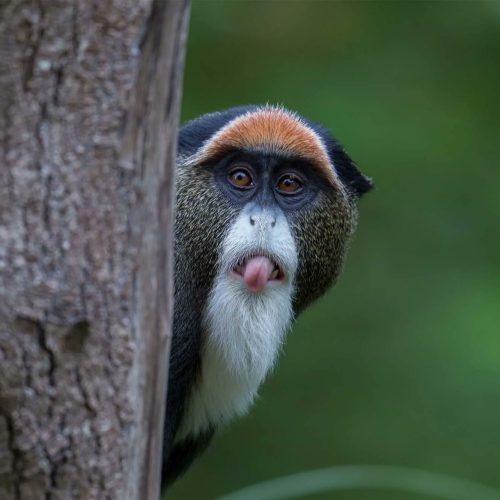
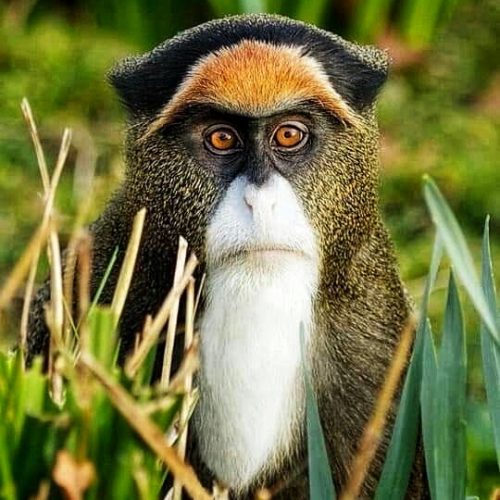
-
These are fewer migrants but can easily move around for food and insects, waking up so early ready with your camera is the crucial agenda to spot these unique monkeys.
-
They prefer canopies but sometimes go on the ground, meaning they are great chances of seeing them
Holiday ideas to see the De Brazza’s monkeys
Its indeed the primate look out, but our experts shall get more closer to these shyer species .
OUR SAFARIS
[pt_view id=”5884fd9war”]





















